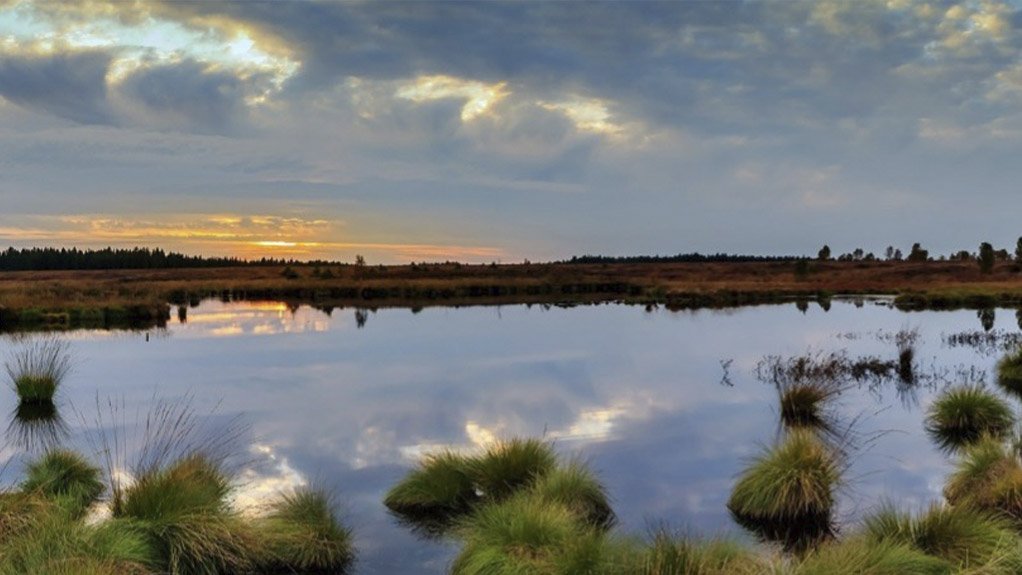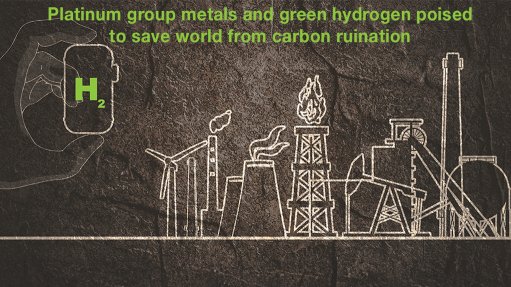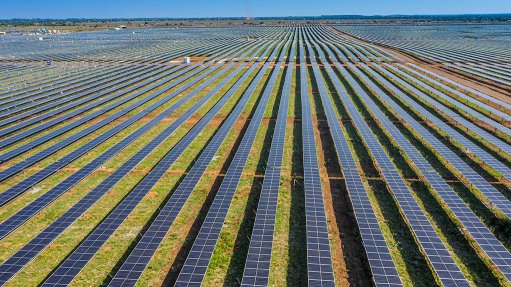The National Wetland Management Framework (NWMF) for South Africa and its potential implementation in the near future
This article has been supplied as a media statement and is not written by Creamer Media. It may be available only for a limited time on this website.
The Importance of Wetlands
(Showroom): According to the US: PEA (2020), wetlands are considered one of the world’s most productive ecosystems, which is even on par with rainforests. Wetlands are referred to as ‘biological supermarkets’ due to their ability to provide various foods to several different fauna. Furthermore, wetlands act as a refuge to a diverse range of flora and fauna (e.g: mammals, insects, fish, amphibians and birds). Wetlands contain imperative ecological infrastructure which perform valuable functions which range from flood protection of adjacent properties that might be situated downstream of a watercourse, regulation of stream flow especially during low flow periods and water quality enhancement (e.g: toxicant and nutrient removal, and sediment trapping) (Edwards et al., 2018). Besides the regulating and supporting services wetlands provide, wetlands also provide provision and cultural services such as harvestable resources (e.g: food, crafts, medicine, fodder), forms part of community cultures, creeds, heritage and custom, and finally due to the high level of biodiversity, wetlands provide an aesthetic appeal which can contribute to tourism and recreation.
From a South African perspective, wetlands are estimated to comprise of <5% within South Africa, however although wetlands cover such a small portion of the land, the supporting and provisioning services that wetlands provide are imperative to the surrounding environment (SANBI, 2019). No matter the size of a wetland, wetlands can be an invaluable resource for people living nearby; providing services such as water for crops and livestock, source of food (e.g: fish) and to a certain degree act as a safety-net for providing resources (e.g: water for domestic purposes) during dry season or periods of low flow. Although wetlands have been stressed to be unique, provide various benefits to the natural environment and surrounding communities of people and recognised at national legislative level, their extent and integrity is continuously being compromised.
Development of the NWMF
The National Wetland Management Framework (NWMF) project commenced in September 2020 with the appointed company to assist with the development of the NWMF being Eco-Pulse Environmental Consulting Services. A Project Steering Committee (PSC) was developed at the inception phase of the project, which was a team that included representatives from Department of Water and Sanitation (DWS), Department of Forestry, Fisheries and Environment (DFFE) and Department of Agriculture, Land Reform and Rural Development (DALRRD). A step-by-step approach was developed in order to guide the development of the framework which includes a series of National Stakeholder Consultations that was utilised to prepare the NWMF Report.
Clarifying the scope and purpose of the NWMF
In order for the development of the NWMF, several alignment meetings and clarification of the scope and purpose of the project was conducted. Furthermore, key terms were established in order to develop the NWMF, which are further described below:
- National: The emphasis of this framework is on guiding wetland management at a national level. The implication here is that it should be focussed principally on identifying strategic imperatives necessary to improve wetland management in South Africa. Given this emphasis at a national level, the framework will seek to provide specific direction for National Departments jointly responsible for wetland management. It is however acknowledged that the framework must have relevance to the challenges and functions of sub-national entities and should therefore be structured in such a manner that it can be unpacked further for application at a sub-national level.
- Wetland: For the purposes of this project, a wetland is defined as per the definition in the South African National Water Act; Act No. 36 of 1998, as “Land which is transitional between terrestrial and aquatic systems where the water table is usually at or near the surface, or the land is periodically covered with shallow water, and which land in normal circumstances supports or would support vegetation typically adapted to life in saturated soil.”
- This definition is considerably narrower than the definition outlined in the Ramsar Convention, which defines wetlands rather broadly, as “areas of marsh, fen, peatland or water, whether natural or artificial, permanent or temporary, with water that is static or flowing, fresh, brackish or salt, including areas of marine water the depth of which at low tide does not exceed six metres” (Ramsar Convention Secretariat, 2016).
- This was a conscious decision made by the PSC in recognition of the differences in regulatory mandates for estuaries and the additional complexity that this could bring to the process. Nevertheless, it is important to acknowledge that there is a continuum between rivers and wetlands that occur outside estuarine functional zones and those situated within these zones. As such, there may be a need to revisit this and integrate wetlands that occur within the estuarine functional zone into future revisions of the framework.
- Management Framework: A combination of interlinked items that provides a structure used to support wetland management. It was agreed that the goals of the framework should seek to foster the following key outcomes:
Collective outlook: The framework should seek to develop clear statements of intent that clarify the aspirations for wetland management at a national level. Such statements should be informed by appropriate contextual information that foregrounds the state and value of wetland management in South Africa. The intention here, is that the framework would help set a solid foundation for the compilation of a National Wetland Policy (NWP).
Directed response: The framework should seek to outline a clear and strategic response for wetland management that is based on an understanding of the challenges, constraints, and opportunities across a broad suite of sectors.
Institutional collaboration: The framework should be developed collaboratively to draw key stakeholders together to support the achievement of desired outcomes. This should be informed by existing mandates and seek to outline roles and responsibilities, particularly in instances where there is a lack of clarity. This will focus principally on strengthening the collaboration of key national departments whilst recognizing the supporting role of other stakeholders.
Vision, Mission and Implementation of the NWMF in the near future
Vision: Wetlands in South Africa are recognised, prioritised and collaboratively governed as high-value ecosystems that provide multiple benefits vital to the well-being of all, now and in the future.
Mission: To adaptively manage, protect, sustainably use and restore wetlands through inclusive, integrated and aligned national, provincial and local actions that are supported by investments, advocacy outreach and science-based, participatory research and learning.
Thus, the implementation of the NWMF in the near future will assist with the conservation, preservation and management of wetlands at a high level. Therefore, the continuous science based research of wetlands is imperative to understand how these systems function and the biodiversity that exist within these systems in all parts of South Africa. Furthermore, reporting on wetlands from a consulting perspective must continue and can form part of high value information for not only research but conservation purposes.
If you require a Wetland Impact Assessment, Wetland Rehabilitation Plan or Wetland Offset Plan, do not hesitate to contact ENVASS for a quote and we would be happy to assist you with understanding of wetland science and the requirements from a reporting perspective for any required authorisation or license.
Comments
Announcements
What's On
Subscribe to improve your user experience...
Option 1 (equivalent of R125 a month):
Receive a weekly copy of Creamer Media's Engineering News & Mining Weekly magazine
(print copy for those in South Africa and e-magazine for those outside of South Africa)
Receive daily email newsletters
Access to full search results
Access archive of magazine back copies
Access to Projects in Progress
Access to ONE Research Report of your choice in PDF format
Option 2 (equivalent of R375 a month):
All benefits from Option 1
PLUS
Access to Creamer Media's Research Channel Africa for ALL Research Reports, in PDF format, on various industrial and mining sectors
including Electricity; Water; Energy Transition; Hydrogen; Roads, Rail and Ports; Coal; Gold; Platinum; Battery Metals; etc.
Already a subscriber?
Forgotten your password?
Receive weekly copy of Creamer Media's Engineering News & Mining Weekly magazine (print copy for those in South Africa and e-magazine for those outside of South Africa)
➕
Recieve daily email newsletters
➕
Access to full search results
➕
Access archive of magazine back copies
➕
Access to Projects in Progress
➕
Access to ONE Research Report of your choice in PDF format
RESEARCH CHANNEL AFRICA
R4500 (equivalent of R375 a month)
SUBSCRIBEAll benefits from Option 1
➕
Access to Creamer Media's Research Channel Africa for ALL Research Reports on various industrial and mining sectors, in PDF format, including on:
Electricity
➕
Water
➕
Energy Transition
➕
Hydrogen
➕
Roads, Rail and Ports
➕
Coal
➕
Gold
➕
Platinum
➕
Battery Metals
➕
etc.
Receive all benefits from Option 1 or Option 2 delivered to numerous people at your company
➕
Multiple User names and Passwords for simultaneous log-ins
➕
Intranet integration access to all in your organisation





















